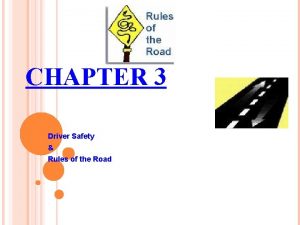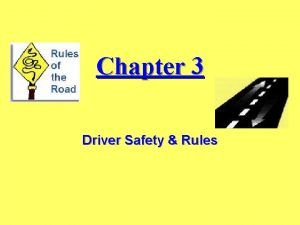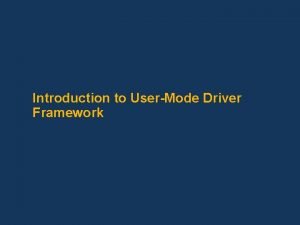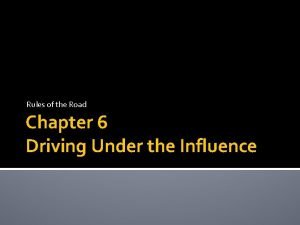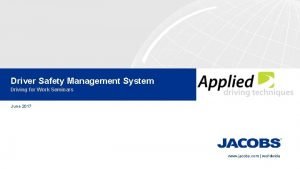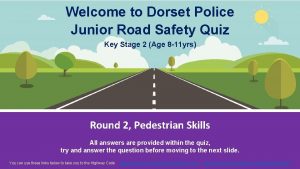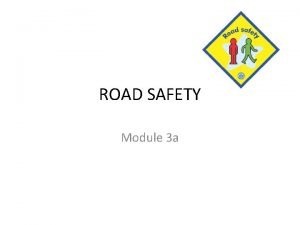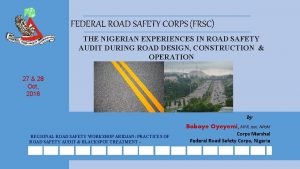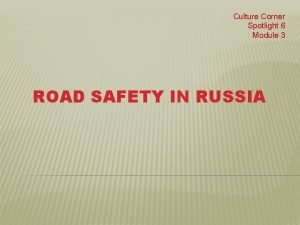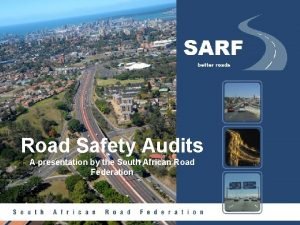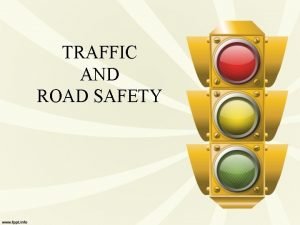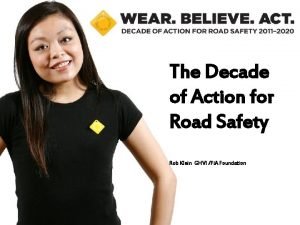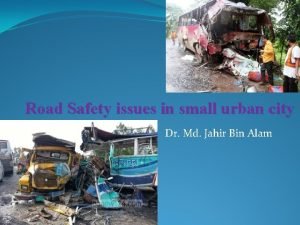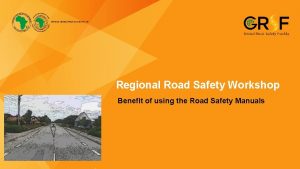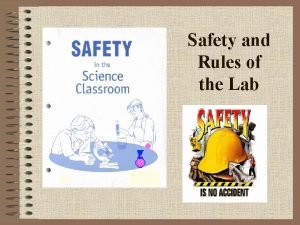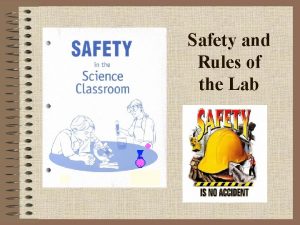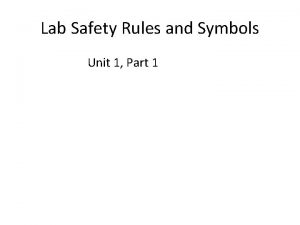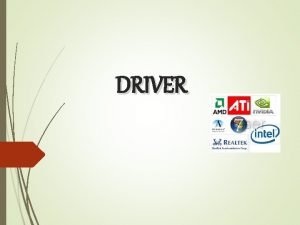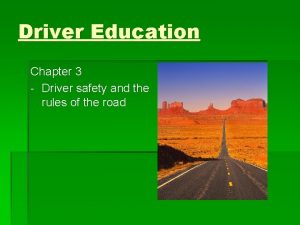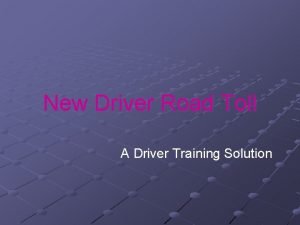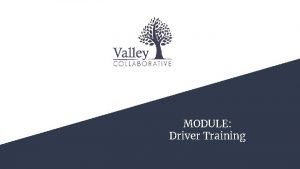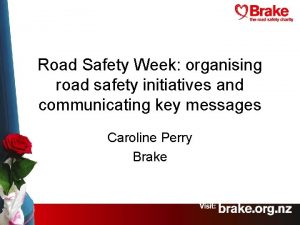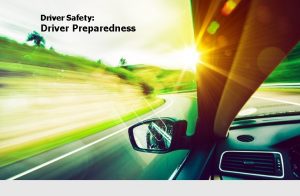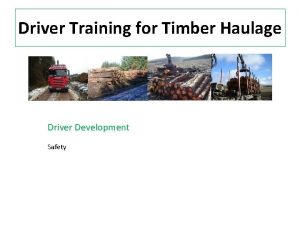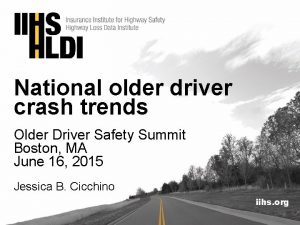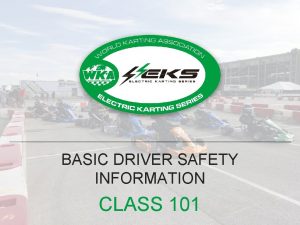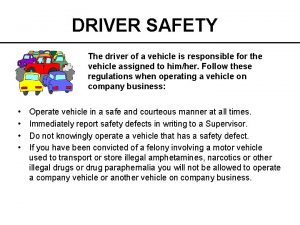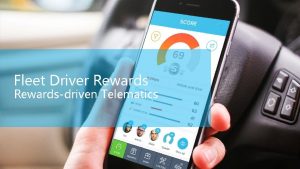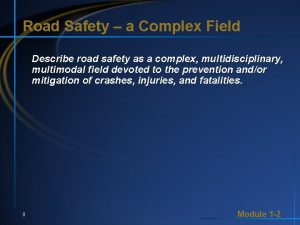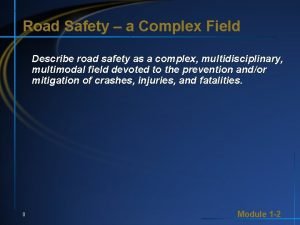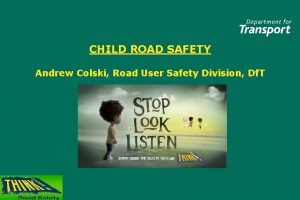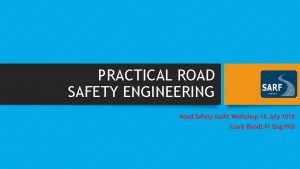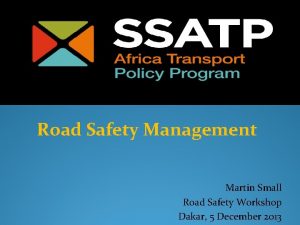Driver Safety and Rules of the Road Chapter






































































- Slides: 70

Driver Safety and Rules of the Road Chapter 3

The NJ Seatbelt LAW Requires: all front-seat occupants of passenger vehicles to wear a seat belt.

The NJ Seatbelt LAW Who is Responsible for this Law…. Motorist : for all passengers under 18 years of age. Passengers 18 years of age and over: responsible for themselves. Police may pull over vehicle solely for violation of seatbelt law. Motorists with GDL permits or provisional licenses must use seat belts. Additionally, they must require all passengers seated anywhere in the vehicle to use seat belts.

Passive Safety Devices Provide an appropriate level of protection for vehicle occupants during and after a collision 1. Air Bags 2. Seat Belts 3. Structure of Vehicle

Did you Know? ? Seatbelts can save a life and improve a motorists chances of surviving a crash by 60%!!!! Chances of surviving a collision are three to four times better if he/she is wearing both a seatbelt and a shoulder strap Takes seconds to fasten a seatbelt!

How can seatbelts help? 1. Keep motorists and passengers from being thrown from the vehicle in a collision. =less severe injury If a vehicle hits something, the vehicle stops, but the person keeps going at the same speed that the vehicle was moving. Hitting the dashboard or windshield at 30 mph is like falling from the top of a three-story building.

How can seatbelts help? Cont. . 2. Slow a body down with the vehicle 3. Keep motorist from sliding on seat during sudden stops and turns. 4. Keeps motorist in position so he/she can control vehicle!

Car Seats Traffic Accidents are the leading killer of children!

Car Seats Types: Many INFANT Car seat : will protect a baby up to 20 pounds and 26 inches Must be placed in the vehicle facing the rear when infant less than 17 pounds. After 17 pounds and can sit up, seat can be adjusted to upright pos. an facing forward.

Car Seats TODDLER Convertible car seat: a larger seat that can be used for infant/toddler up to 40 pounds and 40 inches in height.

Car Seats Use Back seat * with infant and no back seat? ? Move front seat as far back as possible Buckle child in appropriate restraint for weight NEVER place rear-facing infant safety seat in front seat with front passengerside air bag.

Child Restraint Law Children up to 8 years or a weight of 80 pounds must ride in a federally approved safety or booster seat in rear seat of vehicle. Children under age 8 and over 80 pounds must be in a rear seat and use a seatbelt. Failure to comply = $54 fine and court costs

Air Bags Could seriously injury or kill children who are sitting in the front seat. Children 12 and under should always ride in back seat! 1995 -NHTSA allowed cutoff switches in pickup trucks, sports cars , and autos with no backseats. 1998 allowed repair shops to install switches in vehicles with appropriate needs.

Air Bags 1986 -2000 front air bags saved lives of 5, 303 front seat riders Inflate at speeds up to 200 mph to protect adults In a front-end collision. An average sized adult who is correctly belted is not likely to come in contact with air bag until fully inflated

How do I know if my car has an airbag? ? Look at: Steering wheel and dashboard panel “Air Bag” “SRS” Supplemental Restraint System “SIR” Supplemental Inflatable Restraint

Car Condition Brakes 1. A motorist should be able to break smoothly and quickly 2. Conventional Disc and drum breaks a motorist should pump them gently after driving through water to test and dry them out 3. If you are driving 20 mph it should take a driver 25 ft to stop.

Anti Lock Break System 5. Motorist should never pump breaks or jerk steering wheel when breaking Test breaks by applying steady pressure Soft surfaces (loose gravel/snow), ABS system may lengthen stopping distance Slippery conditions, motorist should keep safe distance from vehicle in front and maintain a speed consistent with the road conditions.

HORN 6. A horn should not be overused_, but a motorist should check it often to make sure it works

Tires 7. When should a motorist check the tires? If a motorist feels or hears any unusual thumping while driving, he/she should check the tires. Tire pressure should be checked often, especially when tires are cold. 8. What can cause a tire blowout? Bumps, cuts or bad tread can cause blowouts.

Tires 9. Where can you look to determine the proper tire pressure for your vehicle? What can properly inflated tires do for you? A motorist should check the owner’s manual to determine proper tire pressure or should ask for advice at a service station. Properly inflated tires save money in fuel consumption.

SNOW/ICE 10. Snow/Ice-What is the State law require? ? State law (N. J. S. A 39: 4 -77. 1) requires a motorist to remove snow or ice from a vehicle before driving it. If snow or ice dislodges from a moving vehicle, it could strike another vehicle or pedestrian, causing injury or property damage.

Before getting into a car… 11. Before getting into a car to drive, you need to look _behind_____ it and in front_ of it. Why? 1. There are blind spots once a motorist is behind the wheel. Children may be there. 2. There also may be bottles, cans, bicycles or other things that cannot be seen from the motorists seat

Starting a Parked Car 12. While starting a parked car you should also keep in mind 1. All windows should be clean and nothing should block a motorist’s vision. 2. The seat must be adjusted so a motorist can reach all pedals and controls easily. (For most motorists, the seat may be adjusted so he/she is sitting an arm’s length from steering wheel). 3. Inside and outside rearview mirrors should be adjusted.

Starting a Parked Car… 4. Seat belts and shoulder harnesses should be fastened so that they are firm and comfortable. • 5. The vehicle should be in park or neutral gear and the parking brake should be set. 6. Doors should be locked.

Posture 13. A motorist should keep___good____posture while driving. the seat should be adjusted so that the motorist can reach the foot pedals easily. The motorist should be comfortable behind the wheel. He/she should not have to strain to reach the gear shift levers, turn signals or dashboard controls. A motorist is properly positioned when he/she can see clearly and can glance to the rear.

Visual Information? 14. What percentage is all information necessary for safe driving is visual information. 95% A motorist should have an eye checkup every two years. As a motorist ages, visual clarity declines and peripheral vision becomes less distinct. For example, a 60 -year-old perceives light about a third as well as a 20 -year-old.

Blind Spots

Blind Spots 15. What are blind spot? What can help reduce these blind spots? -Blind Spots areas where a motorist cannot see behind his/her vehicle (on both sides) through the mirror. -A motorist can check this by turning his/her head.

Adjusting mirrors

Adjusting Mirror The outside mirror should be adjusted so that the motorist can see the tip of the driver-side front door handle in the lower right of the mirror. This will allow the motorist to see part of the lanes of traffic to the left and rear of the vehicle.




What should a motorist due after starting the engine 16. What should a motorist due after starting the engine? (3) a motorist should make sure his/her path is clear by turning and looking back. (A motorist should not depend on rearview mirrors) A motorist must also be sure to check for pedestrians and less conspicuous vehicles, such as bicycles and mopeds. A motorist should give the proper signal and drive with caution.

Steering 9 3

Steering A motorist’s grip on the steering wheel is important. The steering wheel can be thought of as the face of a clock. For normal driving, a motorist should grip the steering wheel by the outside rim at the 9 and 3 o’clock positions, keeping his/ her thumb along the face of the wheel. Gripping the steering wheel as described diminishes the risk of hand, wrist or arm injury if the air bag is deployed.

Steering Cont. A motorist should never turn the wheel while gripping it from the inside of the rim, hand facing inward. The steering wheel should be held firmly but not too tight, as steady as possible as the vehicle’s speed increases. Both hands should be kept on the wheel at all times, except when shifting gears or giving hand signals.

Lane Positioning 18. When driving where should you keep the vehicle in the lane when in a one-way roadway Center of Lane

Lane Positioning 19. Your car traveling on a twolane road should be kept ______right______ with oncoming traffic in the outer lane.

Hand Over Hand Steering 20. What does hand-over-hand steering permit? Hand-over-hand steering permits a motorist to make steering adjustments ranging from very minor up to a half turn of the wheel, while keeping both hands on the wheel.

Hand Over Hand Steering 21. Hand-over-hand steering is particularly well-suited for the following: (4) Hand-over-hand steering is particularly well- suited for precision maneuvers, steering through curves, intersection entry and exit, and skid recovery.

Speed Control 22. A motorist should start _slowly_______, gradually ___increasing______ speed until safely within the legal speed limit and flow of traffic.

Speed Control 23. What does pressing the break pedal lightly do? This gives other motorists and pedestrians a chance to react accordingly.

Speed Control 24. How can you check you speed? To check speed, a motorist should glance at the speedometer. With practice, a motorist will be able to judge the correct gas- pedal pressure for any speed.

Stopping Distance Your stopping distance depends on: (7) • Motorist reaction time • Weather and road conditions • Vehicle weight • Brake conditions • Condition and type of tires • Roadway conditions • Speed

Faster the Vehicle is moving the longer is will take to stop!

When trying to visualize a distance it is useful to remember that the length of an average car is approximately 15 ft, therefore, 75 ft would be about 5 car lengths away.

Proper Braking 26. Name the two types of braking systems. 1. Conventional Drum 2. ABS 27. What foot should a motorist use for both the gas pedal and break pedal with an automatic transmission? RIGHT FOOT

Driving Signals 28. When should you use a driving signal? A motorist should always give a proper signal when turning, changing lanes, stopping or slowing down. Most vehicles have turn signals and a motorist should always use them. 29. You should always turn on turn signals at least _100_ft___ before turning.

Hand Signals 30. Hand signals are standard in all states and are: Stop or Slow = Right Turn = Left Turn =

Horn 31. A horn is a __warning signal. 32. Who is allowed to use sirens, whistles, or bells? Only emergency vehicles

Driving in Reverse 33. What should a motorist do before driving in reverse? Before driving in reverse, a motorist must be sure that the path is clear. 34. When driving in reverse, steering the wheel to the right moves the care to the ___right___ ; steering to the left moves the car to the __left_____. Not turning the wheel while in reverse, the vehicle will move _straight back_.

Driving in reverse 35. Body positioning while driving in reverse? To drive in reverse, a motorist’s head and body should be turned to the right until he/she can see clearly through the back window of the vehicle without the use of mirrors.

Driving in Reverse 36. Hand positioning while driving in reverse? The motorist’s right hand arm should be placed over the back of the front passenger seat; the left hand should grasp the top of the steering wheel. ** This is the position a motorist should be in to reverse in a straight line, with sight seeing correction made as needed

Reversing 37. If a motorist must turn the wheel while driving in reverse other than in a straight line (parallel parking), where must both hands be? two hands must be on the wheel to steer, while a motorist’s head and body is turned to look out the rear window

Do Not…. . 38. What can cause you to fail the road test? Palming the wheel with one hand while turning in reverse is dangerous and can result in failing the road test.

Reversing 39. The front of the vehicle will always swing in the opposite direction of a turn.

NJ ROAD TEST 40. On the NJ road test you will have to back up the vehicle how many feet? 100 ft

Hill Parking When parking downhill, turn your steering wheel towards the curb. Your wheels will rotate clockwise and your car would roll into/over the curb if it became loose. This is preferred over letting the car roll into traffic When parking uphill, with a curb, turn the steering wheel away from the curb. Your wheel will rotate counterclockwise, and the back of your front tires should hit the curb. This creates a "lock. " When uphill without a curb, turn the steering wheel like the downhill situation- towards the curb. Your car would then curve backwards into the side of the street as opposed to into traffic




Angle Parking 46. Most common type of parking used in parking lots of shopping centers, and sometimes at storefront curbs is ___angle parking_____.

Parallel Parking 47. Most common type of parking on city streets is _parallel parking____.

Parallel Parking Steps… Find a parking space that is large enough to fit the vehicle. Signal for a stop and signal to the right to alert motorists that the vehicle will back up to the right. Pull up alongside (parallel) about two to four feet from the vehicle in front. • Turn and check to see that the way is clear behind the vehicle before backing up. • Turn his/her body to look out the rear window of the vehicle.

Begin backing up slowly for about two feet and turn the steering wheel all the way to the right. • When the front of the vehicle has cleared the rear bumper of the vehicle in front, stop and check the angle. • Make sure the right back wheel has not hit the curb. • Turn the steering wheel all the way to the left while beginning to back up slowly. • Make sure the vehicle can clear its back bumper. • When the vehicle is in line, stop. Be sure not to hit the vehicle in back. • Turn the vehicle’s wheels straight, and drive to the center of the parking space. The vehicle’s tires should be no more than six inches from the curb!!!!! Important!!

Turning Tips Decide well in advance where he/she wants to turn. Last-minute turns can be unsafe. State law requires a motorist to get in the proper lane and signal at least 100 feet before making any turn. The faster the traffic is moving, the sooner a motorist should plan his/her turn. If a turn is missed, a motorist should never back up. It is better to take the next turn than to risk a collision.

Before turning, a motorist should always: • Use the mirrors to look behind and to both sides for other vehicles (or people) to see if it is safe to turn • Check for less visible vehicles, such as motorcycles, bicycles and mopeds • Signal first (use turn signals or hand signals) and then move into the proper lane. • Slow down before reaching an intersection • Keep a steady speed and follow pavement markings • Always stay in the same lane until the turn is finished • Make sure turn signal is turned off after the turn is completed

Turning 3 point turn

3 Point Turn When turning a vehicle around, a motorist should start from the right edge of the road. Choose a safe spot with good visibility in both directions. If there is no other traffic, the motorist should signal left and move forward slowly while turning the steering wheel to the left. The vehicle should be stopped several inches from the left curb or street edge. The motorist should then signal right and back slowly while turning the steering wheel to the right, stopping several inches from the right curb or street edge. The motorist should next move the vehicle forward, signaling left, while turning the steering wheel to the left. Finally, the motorist should straighten the vehicle’s wheels as it faces in the direction he/she wants to go. This is a complete 3 -Point (or K) Turn. A new motorist will be required to make this turn during MVC’s road test.
 Chapter 3 driver safety and rules
Chapter 3 driver safety and rules Chapter 3 driver safety and rules
Chapter 3 driver safety and rules Umdf reflector
Umdf reflector Rules of the road chapter 6 answers
Rules of the road chapter 6 answers Paved road vs unpaved road
Paved road vs unpaved road Safety at street works
Safety at street works Driver safety management system
Driver safety management system Safety driver beograd
Safety driver beograd Road safety true or false quiz
Road safety true or false quiz Road safety vocabulary
Road safety vocabulary Pdo sp 2000 v4
Pdo sp 2000 v4 Vision and mission of frsc
Vision and mission of frsc Global plan decade of action for road safety
Global plan decade of action for road safety Road safety spotlight 6
Road safety spotlight 6 Road safety audit ppt
Road safety audit ppt Floor lieshout
Floor lieshout Why is road safety important
Why is road safety important Road safety
Road safety Slogans on road safety
Slogans on road safety Plan b campaign
Plan b campaign Road safety
Road safety Road safety
Road safety Road safety alert
Road safety alert Road infrastructure safety management
Road infrastructure safety management The new jersey driver manual test
The new jersey driver manual test Rules of the road traffic survival school
Rules of the road traffic survival school Lab safety rules and symbols
Lab safety rules and symbols Safety symbols in computer lab
Safety symbols in computer lab Lab safety test the hypothesis part 3 answer key
Lab safety test the hypothesis part 3 answer key The road to lexington and concord
The road to lexington and concord Hát kết hợp bộ gõ cơ thể
Hát kết hợp bộ gõ cơ thể Slidetodoc
Slidetodoc Bổ thể
Bổ thể Tỉ lệ cơ thể trẻ em
Tỉ lệ cơ thể trẻ em Chó sói
Chó sói Tư thế worms-breton
Tư thế worms-breton Hát lên người ơi alleluia
Hát lên người ơi alleluia Các môn thể thao bắt đầu bằng từ đua
Các môn thể thao bắt đầu bằng từ đua Thế nào là hệ số cao nhất
Thế nào là hệ số cao nhất Các châu lục và đại dương trên thế giới
Các châu lục và đại dương trên thế giới Công thức tính độ biến thiên đông lượng
Công thức tính độ biến thiên đông lượng Trời xanh đây là của chúng ta thể thơ
Trời xanh đây là của chúng ta thể thơ Cách giải mật thư tọa độ
Cách giải mật thư tọa độ 101012 bằng
101012 bằng Phản ứng thế ankan
Phản ứng thế ankan Các châu lục và đại dương trên thế giới
Các châu lục và đại dương trên thế giới Thể thơ truyền thống
Thể thơ truyền thống Quá trình desamine hóa có thể tạo ra
Quá trình desamine hóa có thể tạo ra Một số thể thơ truyền thống
Một số thể thơ truyền thống Cái miệng nó xinh thế chỉ nói điều hay thôi
Cái miệng nó xinh thế chỉ nói điều hay thôi Vẽ hình chiếu vuông góc của vật thể sau
Vẽ hình chiếu vuông góc của vật thể sau Biện pháp chống mỏi cơ
Biện pháp chống mỏi cơ đặc điểm cơ thể của người tối cổ
đặc điểm cơ thể của người tối cổ Thế nào là giọng cùng tên? *
Thế nào là giọng cùng tên? * Vẽ hình chiếu đứng bằng cạnh của vật thể
Vẽ hình chiếu đứng bằng cạnh của vật thể Vẽ hình chiếu vuông góc của vật thể sau
Vẽ hình chiếu vuông góc của vật thể sau Thẻ vin
Thẻ vin đại từ thay thế
đại từ thay thế điện thế nghỉ
điện thế nghỉ Tư thế ngồi viết
Tư thế ngồi viết Diễn thế sinh thái là
Diễn thế sinh thái là Dot
Dot Số nguyên tố là gì
Số nguyên tố là gì Tư thế ngồi viết
Tư thế ngồi viết Lời thề hippocrates
Lời thề hippocrates Thiếu nhi thế giới liên hoan
Thiếu nhi thế giới liên hoan ưu thế lai là gì
ưu thế lai là gì Hổ đẻ mỗi lứa mấy con
Hổ đẻ mỗi lứa mấy con Sự nuôi và dạy con của hươu
Sự nuôi và dạy con của hươu Hệ hô hấp
Hệ hô hấp Từ ngữ thể hiện lòng nhân hậu
Từ ngữ thể hiện lòng nhân hậu
